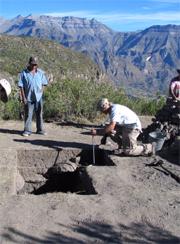 Research highs: an archaeological dig in the Andes showed up signs of early flour.Credit: Daniel H. Sandweiss, University of Maine
Research highs: an archaeological dig in the Andes showed up signs of early flour.Credit: Daniel H. Sandweiss, University of MaineArchaeologists have found the oldest evidence so far of agriculture in the Andes. The discovery shows that ancient Peruvians were growing and eating maize some 4,000 years ago - more than a millennium earlier than previous records had suggested.
Maize was originally cultivated in Mexico, and archaeologists have evidence that the crop was grown as early as 7,000 years ago in Ecuador. But they had previously not known how quickly the practice spread south into the Andes.
The development of agriculture in this area marks a cornerstone in the development of civilization in the Andes: a process that ultimately led to the rise of the Incas, who dominated the region from about 1100 AD until the arrival of European settlers.
Cooking with flour
The discovery came after researchers unearthed the remains of a house at Waynuna, high on the slopes of the Cerro Aycano peak above Peru's Cotahuasi Valley. Inside, on the floor of the dwelling, they found microscopic remains of plants including maize, potato and arrowroot.
Stone tools also found on the hut's floor were covered with plant remains, and the maize grains showed signs of having been ground into flour. This suggests that the inhabitants of Waynuna were growing and processing their own food.
The presence of remains from both cobs and leaves in the hut suggests that the villagers grew and processed their food at the same place, says Linda Perry of the Smithsonian National Museum of Natural History in Washington DC, who led the team of researchers that publishes the work in this week's Nature1. It's unclear exactly what they would have cooked, she adds, "But if they were grinding it into flour, they were probably either making tortillas or a kind of bread."
Trading up
Arrowroot grows in tropical rainforests but not on mountainsides. So its presence in the hut suggests that villagers in Peru's highlands were already trading with lowlanders, says Perry.
"I'm very surprised but delighted to see arrowroot there, because archaeologists always suspected important trade routes between mountains and the tropical forests," Perry says.
Waynuna would have been a great place to settle for early Peruvians. The hut was found at the border between where potatoes could be grown, on the upper slopes, and where maize could be cultivated below. It is also near a rich source of obsidian, one of the most valuable commodities in primitive Andean cultures because of its usefulness for making tools.
Post a comment to this story by visiting our andeanmaize_unearthed.html">newsblog.
-
References
- Perry L., et al. Nature, 440. 76 - 79 (2006). | Article |
